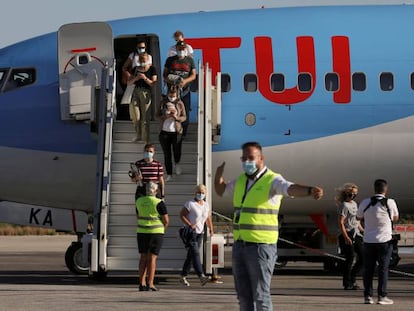Over 1.5 million Spaniards are either jobless or furloughed due to the coronavirus pandemic
A recent report shows that the hospitality, transportation and retail sectors have been worst hit, predominantly affecting Spain’s coastal areas

Six months after Spain first introduced restrictive measures to curb the spread of the coronavirus, including a 99-day lockdown from mid-March to mid-June, more than 1.5 million people are either out of work or still furloughed due to the crisis, according to a report by the association of temporary employment agencies Asempleo.
The figure was reached by taking the 753,000 individuals who were no longer making social security contributions on the last day of August compared with the figure on March 11 (when the lockdown was announced), and adding to it the 810,000 workers who were still on furlough at that time. In total, 1,560,000 people were out of work this September, a figure which in percentage terms equals 8.1% of those who were employed in pre-crisis days. The report also flags up that only three quarters of those affected have registered as unemployed, while the rest have dropped out of the labor force.
The majority of workers bearing the brunt of the economic fallout from the pandemic are in the hospitality, transportation and retail sectors. Lockdown measures, border closures and the subsequent loss of tourists have been disastrous for people working in these areas, particularly those in the hotel industry, with 78% of them losing their jobs or being furloughed between March 11 and April 30, when the economy was in hibernation. This figure is 65% for employees in the food and drink sector, 65% in the recreational sector, and 64% in the aviation industry.
Tourism experienced a degree of respite as restrictions on mobility were eased beginning in May, leading to the creation of 330,000 jobs. Similarly, when the economy reopened following the hibernation, 2.5 million workers on furlough returned to work between April 30 and August 31. However, the rate of re-engagement has slowed in September coinciding with the end of the summer season.
The Canary Islands: in the eye of the storm
Despite a degree of economic revival in August, the hotel industry and the transportation and retail sectors are still far from reaching their pre-crisis employment figures. In the aviation industry, for example, 44% of employees are out of work compared to February, right before Spain began taking measures against the Covid-19 pandemic. This figure rises to 49% for travel agency staff.
Meanwhile, in the hotel industry, the numbers of people in employment in August were far lower than in 2019, when 289,000 new jobs were created between February and August compared to just 3,000 during the same period in 2020. The figures are no better in the retail sector, which has lost 56,000 jobs between February and August of this year, in stark contrast to 2019 when 115,000 jobs were created during the same period.
Not surprisingly, the regions that are highly dependent on international tourism have suffered the most. According to Asempleo’s study, the Canary Islands were hardest hit by the downturn, with Las Palmas losing 18.6% of its jobs between February and August and Tenerife 16.6%, This, in turn, has resulted in a respective fall of 32.0% and 28.9% in GVA (Gross Value Added, a measure of the contribution to gross domestic product made by an individual sector) between the fourth quarter of 2019 and the second quarter of 2020. The same applies to the coastal provinces on the Mediterranean, such as Valencia, which lost 25.1% of its GVA and Castellón, which shed 26.8%, compared to the country’s average GVA loss of 21%.
Employment contracted below the national average of 7% in most Andalusian provinces, such as Huelva (-11.9%), Almeria (-11.3%) and Seville (-7.6%), as well as in Madrid (-10.4%), Barcelona (-10.8%), Valencia (-8.6%) and Bizkaia (-7.2%).
English version by Heather Galloway.
Tu suscripción se está usando en otro dispositivo
¿Quieres añadir otro usuario a tu suscripción?
Si continúas leyendo en este dispositivo, no se podrá leer en el otro.
FlechaTu suscripción se está usando en otro dispositivo y solo puedes acceder a EL PAÍS desde un dispositivo a la vez.
Si quieres compartir tu cuenta, cambia tu suscripción a la modalidad Premium, así podrás añadir otro usuario. Cada uno accederá con su propia cuenta de email, lo que os permitirá personalizar vuestra experiencia en EL PAÍS.
¿Tienes una suscripción de empresa? Accede aquí para contratar más cuentas.
En el caso de no saber quién está usando tu cuenta, te recomendamos cambiar tu contraseña aquí.
Si decides continuar compartiendo tu cuenta, este mensaje se mostrará en tu dispositivo y en el de la otra persona que está usando tu cuenta de forma indefinida, afectando a tu experiencia de lectura. Puedes consultar aquí los términos y condiciones de la suscripción digital.
More information
Últimas noticias
Trump claims peace in Ukraine is near, but Moscow suggests otherwise
A survivor’s account of the Interoceanic Train accident: ‘We were scared because of the speed on the curve’
The Interoceanic Train, the Mexican alternative to the Panama Canal
What is known about the Interoceanic Train derailment in Oaxaca
Most viewed
- Oona Chaplin: ‘I told James Cameron that I was living in a treehouse and starting a permaculture project with a friend’
- Reinhard Genzel, Nobel laureate in physics: ‘One-minute videos will never give you the truth’
- Why the price of coffee has skyrocketed: from Brazilian plantations to specialty coffee houses
- Pablo Escobar’s hippos: A serious environmental problem, 40 years on
- Chevy Chase, the beloved comedian who was a monster off camera: ‘Not everyone hated him, just the people who’ve worked with him’











































